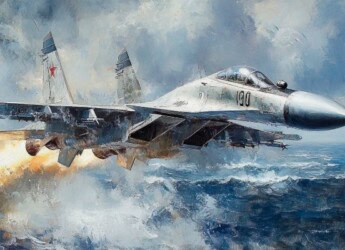|
|
Content Assessment: Bakhmut - A Strategic Success? Russo-Ukrainian War Update (February 28 - March 6, 2023)
Information - 95%
Insight - 94%
Relevance - 91%
Objectivity - 95%
Authority - 94%
94%
Excellent
A short percentage-based assessment of the qualitative benefit of the post highlighting the recent Ukraine conflict assessments in maps from the Institute for the Study of War.
Editor’s Note: The discipline of eDiscovery, which involves the identification, preservation, and analysis of electronic data, is increasingly being used in investigations and litigation relating to war crimes. In the case of the Russo-Ukrainian War, eDiscovery tools and techniques can be used to identify and collect electronic evidence of war crimes, such as emails, social media posts, and other digital communications that may provide valuable insights into the actions of individuals and organizations involved in the conflict. This evidence can then be used in investigations and legal proceedings to hold perpetrators of war crimes accountable for their actions. Additionally, eDiscovery can help to efficiently and effectively manage the vast amount of electronic evidence that may be relevant to war crimes cases, allowing investigators and legal teams to quickly and accurately analyze the data to identify key pieces of information. This weekly update may be useful for cybersecurity, information governance, and legal discovery professionals as they consider investigations and litigation resulting from war crimes committed during the war.
Background Note: One of the most accurate and detailed sources for ongoing updates on the Ukraine crisis is the Russian Offensive Campaign Assessment from the Institute for the Study of War. The Institute for the Study of War (ISW) is a 501(c)(3) organization and produces strictly non-partisan, non-ideological, fact-based research. ISW seeks to promote an informed understanding of war and military affairs through comprehensive, independent, and accessible open-source research and analysis. ISW’s research is made available to the general public, military practitioners, policymakers, and media members. Providing a daily synthesis of key events related to the Russian aggression against Ukraine, ISW updates may benefit investigators and litigators as they follow the business, information technology, and legal trends and trajectories impacted by and stemming from the current Russo-Ukrainian conflict.
Assessment and Maps*
Russo-Ukrainian Conflict Assessments – An Overview in Maps
- Institute for the Study of War (ISW), Russia Team
- Critical Threats Project (CTP), American Enterprise Institute
General Assessment Background Info
- ISW systematically publishes Russian campaign assessments that include maps highlighting the assessed control of terrain in Ukraine and main Russian maneuver axes.
- These maps augment daily synthetic products that cover key events related to renewed Russian aggression against Ukraine.
The Russian Offensive Campaign Assessments
- March 6, 2023
- By Karolina Hird, Kateryna Stepanenko, Grace Mappes, Nicole Wolkov, and Frederick W. Kagan
Key Development
- Ukrainian authorities indicated that Ukraine will continue to defend Bakhmut for now.
Key Takeaways
- Bakhmut is not intrinsically significant operationally or strategically as ISW has previously observed. But Ukraine’s fight for Bakhmut has become strategically significant because of the current composition of Russian forces arrayed in the area. The Battle of Bakhmut may, in fact, severely degrade the Wagner Group’s best forces, depriving Russia of some of its most effective and most difficult-to-replace shock troops.
- Wagner Group head Yevgeny Prigozhin apparently fears that his forces are being expended in exactly this way. The severe degradation or destruction of the elite Wagner fighting force would have positive ramifications beyond the battlefield.
- The Kremlin is returning to its previously unsuccessful volunteer recruitment and crypto-mobilization campaigns to avoid calling the second mobilization wave. The return of the voluntary recruitment and crypto-mobilization campaigns likely indicates that the Kremlin will not launch another mobilization wave at least before the summer 2023 due to spring conscription cycle on April 1.
- A reportedly captured Russian military manual suggests that Russian forces intend to use the newly created “assault detachment” elements in urban warfare.
- Russian forces utilized a new type of guided aerial bomb against Ukrainian targets amid continued precision missile shortages.
- Russian forces continued to conduct ground attacks northwest of Svatove and near Kreminna.
- Russian forces secured territorial gains in Bakhmut but have not yet encircled the city or forced Ukrainian forces to withdraw.
- Russian forces continued to conduct ground attacks near Avdiivka and west of Donetsk City.
- Russian forces continue struggling to maintain fire control over the Dnipro River Delta in Kherson Oblast.
- Russian military command is failing to properly equip its forces despite forces increasingly conducting close combat in Ukraine.
- Ukrainian officials reported on alleged Russian war crimes in Ukraine.
- March 5, 2023
- Grace Mappes, Riley Bailey, Kateryna Stepanenko, Nicole Wolkov, and Frederick W. Kagan
Key Development
- Ukrainian forces may be conducting a limited fighting withdrawal in eastern Bakhmut and are continuing to inflict high casualties against the advancing mixed Russian forces. Russian milbloggers have also lowered their expectations of Russian forces’ ability to launch additional offensives, which would likely culminate whether or not Russian forces actually capture Bakhmut. If Russian forces manage to secure Bakhmut they could then attempt renewed pushes towards one or both of Kostyantynivka or Slovyansk but would struggle with endemic personnel and equipment constraints. The likely imminent culmination of the Russian offensive around Bakhmut before or after its fall, the already culminated Russian offensive around Vuhledar, and the stalling Russian offensive in Luhansk Oblast are likely setting robust conditions for a future Ukrainian counteroffensive.
Key Takeaways
- Ukrainian forces are likely conducting a limited tactical withdrawal in Bakhmut, although it is still too early to assess Ukrainian intentions concerning a complete withdrawal from the city.
- The Ukrainian defense of Bakhmut remains strategically sound as it continues to consume Russian manpower and equipment as long as Ukrainian forces do not suffer excessive casualties.
- The Russian military’s attritional campaign to capture Bakhmut has likely prompted Russian milbloggers to adopt more realistic expectations for further Russian operations in Ukraine.
- The Russian offensive to capture Bakhmut will likely culminate whether Russian forces capture the city or not, and the Russian military will likely struggle to maintain any subsequent offensive operations for some months.
- Endemic personnel and equipment constraints will likely prevent Russian forces from launching another prolonged offensive operation like the Battle for Bakhmut in the coming months.
- The Russian Armed Forces will continue to rely on irregular formations in further offensive operations in the coming months.
- Russian forces would have the choice of two diverging lines of advance after capturing Bakhmut but would likely struggle to sustain offensive operations and make any significant gains.
- It is not clear if Russian forces intend to resume offensives near Vuhledar, and it is highly unlikely that Russian forces would advance far enough in this direction to support operations elsewhere in any case.
- The likely imminent culmination of the Russian offensive around Bakhmut, the already culminated Russian offensive around Vuhledar, and the stalling Russian offensive in Luhansk Oblast are likely setting robust conditions for Ukrainian counteroffensive operations.
- March 4, 2023
- By Karolina Hird, Riley Bailey, Angela Howard, Nicole Wolkov, George Barros, and Frederick W. Kagan
Key Development
- Russian forces appear to have secured a sufficient positional advantage to conduct a turning movement against certain parts of Bakhmut but have not yet forced Ukrainian forces to withdraw and will likely not be able to encircle the city soon.
Key Takeaways
- The purpose of a turning movement is to force the enemy to abandon prepared defensive positions and is different from the aim of an encirclement, which is to trap and destroy enemy forces. The Russians may have intended to encircle Ukrainian forces in Bakhmut, but the Ukrainian command has signaled that it will likely withdraw rather than risk an encirclement.
- Russian Defense Minister Sergei Shoigu met with Eastern Military District Commander Colonel General Rustam Muradov in western Donetsk Oblast, likely to assess the extent of Russian losses around Vuhledar and the possibility of a further offensive in this direction.
- The Chinese government is reportedly angry with the Kremlin over the publicization of arms sales discussions.
- Russian State Duma Defense Committee Head Andrey Kartapalov encouraged Russian companies to purchase their own air defense systems to defend against drones.
- The Wagner Group reportedly opened at least three new recruitment centers at Russian sports clubs between March 2-4, possibly to augment Wagner’s recruitment base after losing access to prisoner recruits.
- Russian forces conducted offensive actions along the Kupyansk-Svatove-Kreminna line.
- Russian forces continued efforts to encircle Bakhmut and conduct ground attacks along the Donetsk Oblast front line.
- Ukrainian sources continue to report that Russian forces are trying to set conditions for offensive operations in southern Ukraine.
- Chechen Republic Head Ramzan Kadyrov continues apparent efforts to increase Chechen influence within Russia through promoting Chechnya’s Special Forces (SPETSNAZ) and youth policy efforts.
- Russian occupation administrations are strengthening law enforcement measures in occupied territories.
- March 3, 2023
- By Karolina Hird, Grace Mappes, Nicole Wolkov, Layne Philipson, and Frederick W. Kagan
Key Development
- Ukrainian forces appear to be setting conditions for a controlled fighting withdrawal from parts of Bakhmut.
Key Takeaways
- Russian officials continued to release limited information about the March 2 incursion in Bryansk Oblast but failed to provide clarity about what actually transpired.
- Russian President Vladimir Putin did not address the reported situation in Bryansk Oblast in an emergency meeting with the Russian Security Council according to the meeting’s readout.
- Russian authorities continued efforts to portray Russia as the only safe operator of the Zaporizhzhia Nuclear Power Plant (ZNPP), likely to constrain the International Atomic Energy Agency (IAEA) presence at the ZNPP and compel the de facto recognition of Russian ownership of the ZNPP.
- Russian forces continued offensive operations along the Kupyansk-Svatove-Kreminna line.
- Russian forces continued ground attacks along the Donetsk Oblast front line as Ukrainian forces appeared to prepare for a controlled withdrawal from at least parts of Bakhmut.
- The Kremlin continues efforts to increase government oversight of the Russian defense industrial base (DIB).
- Russian occupation authorities continue to prepare occupied territories for the September 10 Russian regional elections.
- March 2, 2023
- By Kateryna Stepanenko, Riley Bailey, Grace Mappes, Angela Howard, George Barros, and Frederick W. Kagan
Key Development
- The Kremlin accused Ukraine of conducting a border incursion in Bryansk Oblast, Russia on March 2 — a claim that Ukrainian officials denied.
Key Takeaways
- The alleged Bryansk incident generated speculations from Russian officials and ultranationalist groups about the Kremlin’s response to the situation.
- German Chancellor Olaf Scholz stated on March 2 that Germany is negotiating with allies about providing security guarantees to Ukraine but provided no further details on these proposed guarantees.
- US Secretary of State Antony Blinken briefly spoke with Russian Foreign Minister Sergei Lavrov at the G20 summit in New Delhi, India on March 2 about Russia’s suspension of the New Strategic Offensive Arms Reduction Treaty (New START). The Kremlin very probably is weaponizing New START and fears of nuclear escalation in hopes of deterring Western support for Ukraine.
- Russian authorities appear to be concerned over a growing loss of leverage in Serbia, which Russia has worked to integrate into the Russian sphere of influence for many years.
- Russian ultranationalists continue to debate the appropriateness of criticism of Russian war efforts and to react to proposed increased punishments for “discrediting” the war in Ukraine.
- Russian forces continued limited ground attacks northeast of Kupyansk and offensive operations around Kreminna.
- Russian forces continued offensive operations around Bakhmut, along the western outskirts of Donetsk City, and in western Donetsk Oblast.
- Russian forces appear to have temporarily scaled back efforts to encircle Bakhmut from the southwest as well as from the northeast and may instead be focusing on pressuring Ukrainian forces to withdraw from the city by concentrating on the northeastern offensive.
- Russian sources claimed that Russian forces downed two Ukrainian UAVs in Crimea.
- Wagner Group financier Yevgeny Prigozhin announced that the Wagner Group has launched recruiting efforts through Russian sports clubs.
- Russian occupation officials denied reports of the deportation of Ukrainian children to Russian territories.
- March 1, 2023
- By Kateryna Stepanenko, Karolina Hird, Riley Bailey, Grace Mappes, George Barros, Layne Philipson, and Mason Clark
Key Development
- The Kremlin may leverage an amendment to Russia’s Criminal Code increasing punishments for “discrediting” the war in Ukraine to promote further self-censorship among the critical ultranationalist community, prompting pushback from Wagner Group financier Yevgeny Prigozhin and prominent milbloggers.
Key Takeaways
- A New York Times (NYT) investigation into catastrophic Russian losses during the recent Russian offensive near Vuhledar indicates the Russian military remains unable to rapidly fix the endemic challenges posed by severe personnel and equipment losses.
- Belarusian President Alexander Lukashenko and Chinese President Xi Jinping signed a package of 16 documents that may facilitate Russian sanctions evasion by channeling Chinese aid to Russia through Belarus.
- US officials continue to report that Ukrainian forces are properly using Western-provided weapons in Ukraine.
- Russian and occupation authorities may be attempting to further limit the International Atomic Energy Agency (IAEA) presence at the Zaporizhzhia Nuclear Power Plant (ZNPP) to compel the de facto recognition of Russian ownership of the plant.
- Politico reported that Serbian President Aleksandar Vučić is seemingly reconsidering Serbia’s close ties to Russia during the war in Ukraine, spurred in part by ongoing Wagner Group recruitment and subversion efforts in Serbia.
- Russian forces are fortifying positions on the international border in Belgorod Oblast.
- Russian forces advanced within Bakhmut and continued ground attacks around Bakhmut and in the Avdiivka-Donetsk City area.
- Russian forces continued to conduct offensive operations on the Kupyansk-Svatove-Kreminna line.
- Russian forces continue defensive operations in southern Ukraine.
- Russian occupation authorities continue to struggle with the administrative management of occupied areas.
- February 28, 2023
- By Karolina Hird, Riley Bailey, George Barros, Nicole Wolkov, Angela Howard, and Frederick W. Kagan
Key Development
- Russian authorities appear to be escalating their promotion of false flag information operations to distract from their lack of tangible battlefield gains and slow down the provision of Western tanks and other aid in advance of expected Ukrainian counter-offensives.
Key Takeaways
- US Undersecretary of Defense for Policy Colin Kahl stated that the US has no indication that Russian forces will use nuclear weapons in Ukraine.
- Russian President Vladimir Putin emphasized the role of the Russian Federal Security Service (FSB) in supporting the war in Ukraine during an address to the FSB board.
- The Kremlin and Belarusian President Alexander Lukashenko are likely attempting to intensify efforts to falsely portray Russia as open to negotiations to end its war in Ukraine.
- Lukashenko may facilitate Sino-Russian sanctions evasion schemes during his official trip to Beijing, China from February 28 to March 2.
- Russian forces conducted limited ground attacks near Svatove and Kreminna and likely made limited advances north of Kreminna.
- Russian forces made tactical gains in northern Bakhmut and continued ground attacks around Bakhmut and in the Avdiivka-Donetsk City area.
- Ukrainian officials continue to report potential Russian preparations for renewed offensive operations in Zaporizhia and Kherson oblasts, though ISW has not observed indicators that Russian forces plan to renew offensive operations in these directions.
- Armenian authorities detained a Russian citizen in Yerevan for an act of protest against the war in Ukraine committed in Moscow in July 2022.
- Ukrainian President Volodymyr Zelensky enacted a Ukrainian National Security and Defense Council decision to sanction 109 Russian citizens involved in the forced deportation of Ukrainian children.
We do not report in detail on Russian war crimes because those activities are well-covered in Western media and do not directly affect the military operations we are assessing and forecasting. We will continue to evaluate and report on the effects of these criminal activities on the Ukrainian military and population and specifically on combat in Ukrainian urban areas. We utterly condemn these Russian violations of the laws of armed conflict, Geneva Conventions, and humanity even though we do not describe them in these reports.
Chronology of Maps from February 28 – March 6, 2023 – Mouseover to Scroll
Ukraine Conflict Maps - 022823 - 030623See the Institute for the Study of War Interactive Map of the Russian Invasion
Read the latest Ukraine Conflict updates from the Institute for the Study of War
* Shared with direct express permission from the Institute for the Study of War (ISW).
About the Institute for the Study of War Research Methodology
ISW’s research methodology relies on both primary and secondary sources, enabling researchers to develop a comprehensive understanding of the situation on the ground. In order to analyze military and political developments in any given area, ISW’s research analysts must wholly understand the systems of enemy and friendly forces. They must also understand the population demographics, physical terrain, politics, and history of that area. This lays the analytical foundation for understanding the reasons for particular developments and fulfilling their assigned research objectives. ISW analysts also spend time in places like Iraq, Afghanistan, and elsewhere in order to gain a better understanding of the security and political situation and to evaluate the implementation of current strategies and policies. Our researchers compile data and analyze trends, producing a granular analysis of developments in areas of research, producing an accurate, high-resolution, timely, and thorough picture of the situation. ISW’s research methodology guarantees its success and commitment to improving the nation’s ability to execute military operations, achieve strategic objectives, and respond to emerging problems that may require the use of American military power.
About the Institute for the Study of War
The Institute for the Study of War advances an informed understanding of military affairs through reliable research, trusted analysis, and innovative education. We are committed to improving the nation’s ability to execute military operations and respond to emerging threats in order to achieve U.S. strategic objectives. ISW is a non-partisan, non-profit, public policy research organization.
Learn more, get involved, and contribute today.
Additional Reading
- From Dissent to OSINT? Understanding, Influencing, and Protecting Roles, Reputation, and Revenue
- [Annual Update] International Cyber Law in Practice: Interactive Toolkit
- Data Embassies: Sovereignty, Security, and Continuity for Nation-States
Source: ComplexDiscovery



























